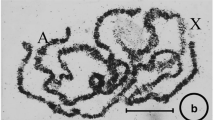Summary
The expression of the extra-sexcomb phenotype is enhanced in males that are doubly heterozygous for mutants from two non-allelic loci,‘extra-sexcomb’ (Polycomb, Extra-sexcomb) and‘bithorax’ (bithorax, bithoraxoid, Ultrabithorax) as compared to the expression of the ‘extra-sexcomb’ mutants when no ‘bithorax’ mutants are present in the genotype. If the ‘bithorax’ mutants are recessive, the expression is usually greater when the non-allelic mutants are cis-hererozygotes than when they are trans-heterozygotes, but there is no difference between cis-and trans-heterozygotes in ‘extra-sexcomb’ andUltrabithorax compounds.
Similar content being viewed by others
Literature
Bridges, C. B., andK. Brehme: Mutants ofDrosophila melanogaster. Carn. Instn. (Wash.) Publ.552, 257 (1944).
Carlson, E. A.: Comparative genetics of complex loci. Quart. Rev. Biol.34, 33–67 (1959).
Gibson, J. B., andJ. M. Thoday: An apparent 20 map-unit position effect. Nature (Lond.)196, 661–662 (1962).
Goldschmidt, R. B.: Theoretical Genetics. 563 pp. Berkeley: University of California Press 1955.
Hannah, A., andØ. Strömnaes: Extra sexcomb mutants inDrosophila melanogaster. Dros. Inform. Serv.29, 121–123 (1955).
Hannah-Alava, A.: Developmental genetics of the posterior legs ofDrosophila melanogaster. Genetics43, 878–905 (1958).
Lewis, E. B.: The phenomenon of position effect. Advanc. Genet.3, 73–115 (1950).
—: Pseudoallelism and gene evolution. Cold. Spr. Harb. Symp. quant. Biol.16, 159–174 (1951).
—: The theory and application of a new method of detecting chromosomal rearrangements inDrosophila melanogaster. Amer. Nat.88, 225–239 (1954).
—: Some aspects of position pseudoallelism. Amer. Nat.89, 73–89 (1955).
—: Genes and developmental pathways. Amer. Zoologist3, 33–56 (1963).
—, andR. F. Mislove: Report on mutants. Dros. Inform. Serv.27, 57–58 (1953).
Lyon, M. F.: Attempts to test the inactive-X theory of dosage compensation in mammals. Genet. Res.4, 93–103 (1963).
Pontecorvo, G.: Trends in genetic analysis. 145 pp. New York: Columbia University Press 1958.
Stern, C.: Genes and developmental patterns. Proc. IX Intern. Congr. Genet. Caryologia6 (Suppl.), 355–369 (1954).
Sturtevant, A. H.: A further study of the so-called mutations at the bar locus ofDrosophila. Genetics13, 401–409 (1928). Cited by Lewis, 1951.
Author information
Authors and Affiliations
Additional information
This work, begun while the author was a member of the staff of the Zoology Dept. of the University of California at Berkeley, was completed, with the assistance of a National Institutes of Health research grant (RG-6754), in the Dept. of Genetics of the University of Turku.
Rights and permissions
About this article
Cite this article
Hannah-Alava, A. Interaction of non-allelic loci in expression of the extra-sexcomb phenotype inDrosophila melanogaster . Zeitschrift für Vererbungslehre 95, 1–9 (1964). https://doi.org/10.1007/BF00898179
Received:
Issue Date:
DOI: https://doi.org/10.1007/BF00898179




